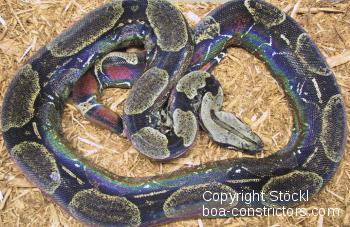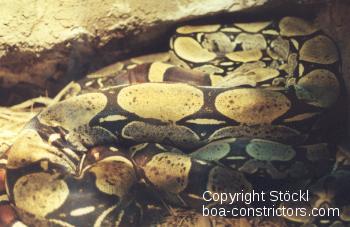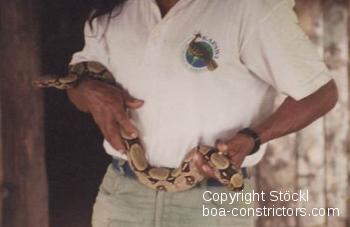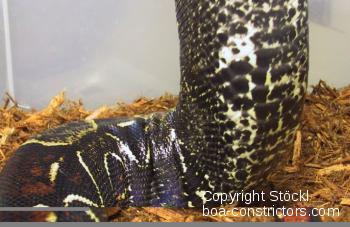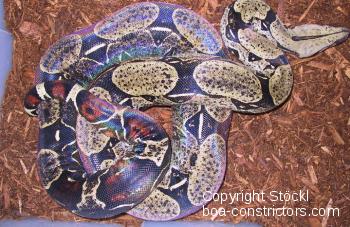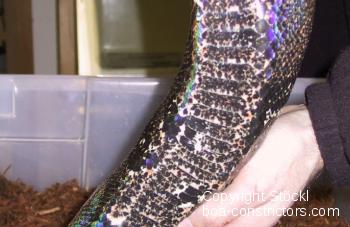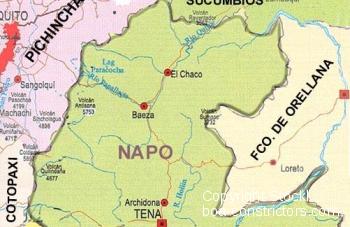Boa constrictor melanogaster information | black bellied boas information | size of Boa c. melanogaster | Boa c. melanogaster breeders | Boa c. melanogaster offspring | Black bellied Boas for sale | information on black bellied boas | true Boa c. melanogaster
While researching boas of Peru back in 1989 my brother, Paul Russo and I came a cross a few very black boa constrictors with black bellies and Red tails. These boas were offered to us because we were looking for dark boas, as we were comparing dark Boas to our recent discovery ( the undescribed Boa c. longicauda or Tumbes Peru boa ). We did not know the origin of these Black Bellied, Red Tailed snakes but were told they may be the rare and elusive Boa c. melanogaster of Ecuador. At that time these boas were presumed to have been from Peru and were sometimes misidentified as the not yet described Tumbes Peru boa. One was even sold to us a Tumbes Boa. But odviously it was not. I regret now that I did not photograph those Black Bellied boas. But their image is trapped in my memory. We also did not pay much attention to those boas due to the fact that they had been already described by James K.Langhammer in 1983. We were also aware of the controversy over the validity of this supposed new Sub Species. So therefore we did not bother researching them further because our interest was aimed at our new Tumbes Boa. It wasn’t till many years later that I realized that I had not seen these Black Bellied, Red Tailed boas again. The timeline that these boas had come into the country ( U.S. ) was about the same as the Tumbes boa ( 1989 – 1994 ). It was then that I decided to try and track down the Black Bellied Boa of Ecuador.
My search started in January of 2001, as my wife and I embarked on a 2 week journey to the Amazon Jungles of East Ecuador. This trip had suddenly peaked my interest in this elusive Black Bellied boa again. At the time I was very well aware that we were in Boa c. melanogaster territory ( Morona Santiago Province ) but I was also curious to see if this Boa really does exist in Ecuador. I did not find the elusive Boa c. melanogaster , but instead found some very interesting Boas.
One of the Boas was a beautiful Redtail Boa c. constrictor that was captured by an Achuar Indian named Walter. This boa was found on his property at the intersection of the Pastaza River and the Capahuari River. And this place was about 50 miles north of the Peru border. I studied this Boa as best I could in the little time I had at Walters. I also took many photos for future reference. But this particular boa was very similar to what most Boa enthusiast are calling Peruvian Redtails.
Obviously since we were so close to Peru that this boa was similar. But why wasn’t it dark like Langhammers Boa c. melanogaster of the Morona Santiago Province, Ecuador? We were well within the range described by Langhammer as “ the convergence of the Rio Yaupi & the Rio Santiago in the Morona Santiago Province “ and also “ from Tena on the Rio Napo in the Napo Province”. The Pastaza River is the Southern Border of the Morona Santiago Province and the Rio Napo is the Northern border. At the same time, the Rio Napo is the Southern border of the Napo Province.
I continued my search but this time it was in the concrete Jungle of Quito Ecuador. There I met Maria Elena of the Vivarium, a beautifull Serpentarium. She had a huge collection of Boas & Vipers that are native to Ecuador. She had three Beautiful Redtail Boas ( Boa c. constrictor ) that were also Captured in East Ecuador. But she did not know the Exact location. Now these boas were a little darker than Walters boas, but not quite as dark as Langhammers melanogaster. I took many photos of these Boas to study. I studied them even more when I returned to the States.
Upon my return to the states I had to find this elusive melanogaster. A friend had emailed me a photo of a snake that was housed in a Pet Shop in Texas. This Boa was exactly like the Boas that I had seen back in 1989. It was very Black with a Black Belly and Red tail. It was identical to Langhammers Boa c. melanogaster. I told my friend to see if he could purchase this snake for me. After a few months the store closed and I got the Snake. I also found a female by posting an ad on the internet. I received many photos of dark Guyana Boas, but only a few of the dark boas that looked like melanogaster.
I started counting scales to see if my boas keyed out to Langhammers Boa. But while researching Langhammers description I remembered something that my Brother, Paul Russo and Dr. Robert Price had mentioned in our description of Boa c. longicauda. It was the fact that Langhammer had blatantly disregarded the fact that Boa c. constrictors high dorsal scale counts ( 88 to 95 ) had already been documented many times by very well respected Herpetologists. Langhammer had stated that snakes with dorsal scale counts in excess of 88 were most likely misidentified melanogaster. I myself totally disagree with Langhammer because if that were true, than basically all constrictor constrictor would be misidentified melanogaster. Putting all this aside, I still wanted to know if my dark Boas were in fact melanogaster.
Langhammer’s scale counts in his description are as follows: Dorsal scales at the 10th saddle are 86-94, Ventral scales 237-252, Subcaudal scales 45-54 and Saddles 20-21 between snout and vent.
My Boas scale counts are as follows ( Male ): Dorsal scales at the 10th saddle 90, Ventrals 247, Subcaudals 54 and 20 Saddles.
My Females scale counts are: Dorsal scales at the 10th saddle 94, Ventrals 238, Subcaudals 53 and 20 Saddles too.
While searching for my Boas I met a man from Florida. He had a boa that was caught by John Johnson while on a trip to Ecuador. It was found near the Aquaro River close to Santa Cecilia in Napo Province. This Boa was well within the range of melanogaster based on Langhammers data.
This boa, a female had the following scale counts: Dorsal scales at the 10th saddle 89, Ventrals 242, Subcaudals 48, and 20 Saddles also.
After all the counting and comparing, I was convinced that we had found at least 3 melanogaster. But I didn’t want to stop there. So I had my friends Gus Rentfro of Texas and Kevin Barnett of Florida, send me shed skins from their Pucallpa and Iquitos Peruvian Redtails ( Boa c. constrictor ). I figured that since the Boas I had seen during my trip were so similar to Peruvian Redtails, that I should also compare these scale counts with the Peruvian Boas. This is when the fun started.
Kevin Barnetts Iquitos Peruvian ( Boa c. constrictor ) female had the following scale counts: Dorsal scales at the 10th saddle 91, Ventrals 243, Subcaudals 48 and 18 saddles.
Gus Rentfros Iquitos Peruvian ( Boa c. constrictor ) female had: Dorsals scales at the 10th saddle 89, Ventrals 245. Subcaudals 48 and 20 saddles.
His Pucallpa Peruvian ( Boa c. constrictor ) had exactly the same scale counts as the Iquitos Boa.
Obviously all this scale counting resulted in very similar ( almost identical ) scale counts between melanogaster and constrictor. So the questions still remained:
Is Boa c. melanogaster just a misidentified Boa c. constrictor ?
It appears to me that after all the research - in reality – they are just that – Boa c. constrictor
I personally think that even though it is not a Valid Subspecies of Boa, it is definitely a valid locality and color morph boa ( like the Peruvian Red Tails or Brazilian Red Tails ). I also think that most of the boas that resemble this melanogaster probably came into the U.S. via Peru. I think this because I am not aware of any Boas that were ever Exported out of Ecuador. But just because they came from a Peruvian exporter, doesn’t necessarily mean that they were captured in Peru. They could have been captured near the Peru border in Ecuador or as Langhammer mentioned in his description that their range could be as far south as Peru. This is probably true due to the fact that snakes do not know Political borders and their range could easily be south into Peru. Secondly, these boas were coming into the Country about the same time as the Tumbes (longicauda ) boa and that further validates a time line.
The two Black Bellied boas in my collection were both brought into the country about 10 years ago. And as for scale counts – they match up to Langhammers description ( even though that doesn’t mean much considering how close they are to Peruvian Boa scale counts). The over all dark Black background color and Black Belly to me are a dead giveaway also. So based on these facts along with the time line of importation, I am confident that these boas are what Langhammer described as the Ecuadorian Black Bellied Boa.
In conclusion I would like to quote Dr. Robert Price ( Co author of the Boa c. longicauda description ). He said “ With regard to Boa c. melanogaster, Langhammers (1983 ) poor taxonomic procedure renders this name a nomen dubium, although it may well be a recognizable taxon “
I think this one quote pretty much says it all. Nomen dubiem is Latin and literally translated means: Name, doubt, hesitation, reservation. But amongst the scientific community it means: nomen dubium: - when used to refer to dinosaur classification means that fossil material is too incomplete to allow proper classification. The original name is retained for reference and the classification may be revised when further material is available.
Therefore even though this color morph, Ecuadorian Black Belly boa is in reality Boa c. constrictor
(the original name ), this does not mean that it should be used as genetic material to create mutt boas. I heard one breeder say he wanted to breed it to an Albino boa to get whiter albinos. I have also seen cross breeds between the Black Belly boa and a Peruvian Boa.
I find it a shame that breeders will not take the time to find a locality specific mate to their snakes. Some American breeders would rather breed two boas ( with blatant disregard as to locality data ), just to get more Boas to sell. I feel that if we don’t preserve the Boa constrictor bloodlines in Captivity and keep them pure, that one day these snakes may be extinct in the wild. And the only things left will be genetic junk from captive cross breeding.
Vincent P. Russo
We would like to thank our friend Vin for publishing this account on our website. In our opinion, he did a great job with this research. He sheds light on the "melanogaster topic". We always thought, that "Boa c. melanogaster" is just a local variation of Boa c. constrictor. It is thanks to Vin that this assumption seems to be proven now.
H+E Stoeckl
Acknowledgements: I would like to thank the following for providing comments, data & shed skins:
Gus Rentfro of Rio Bravo Reptiles & Kevin Barnett of Ectothermics.
Literature Cited:
Price & Russo (1991) Revisionary Comments On The Genus Boa With The Description Of A New Subspecies Of Boa Constrictor From Peru, The Snake, Japan Snake Institute, Volume 23 # 1, June 1991, Pages 29–35.
James K. Langhammer (1983) A New Subspecies of Boa constrictor, Boa constrictor melanogaster. From Ecuador, Tropical Fish Hobbyist, Volume 32 # 4, December 1983 Pages 70-76

